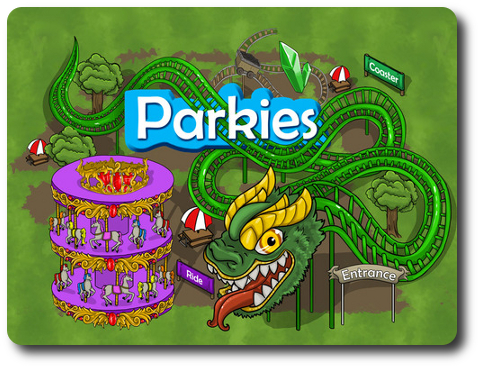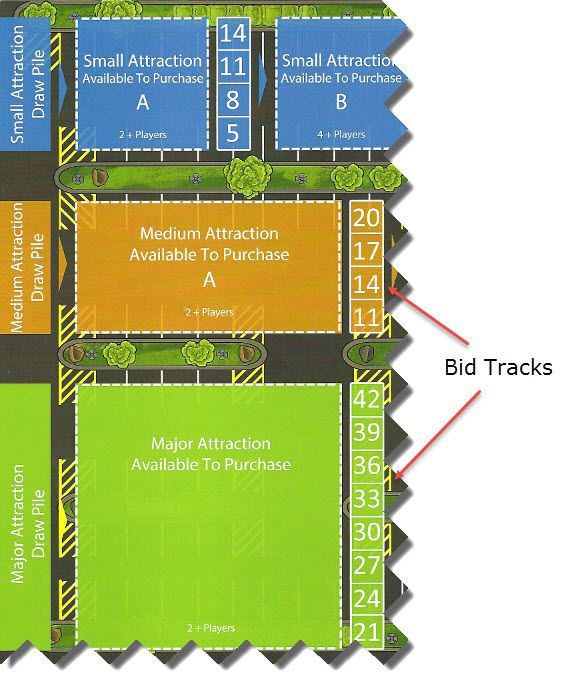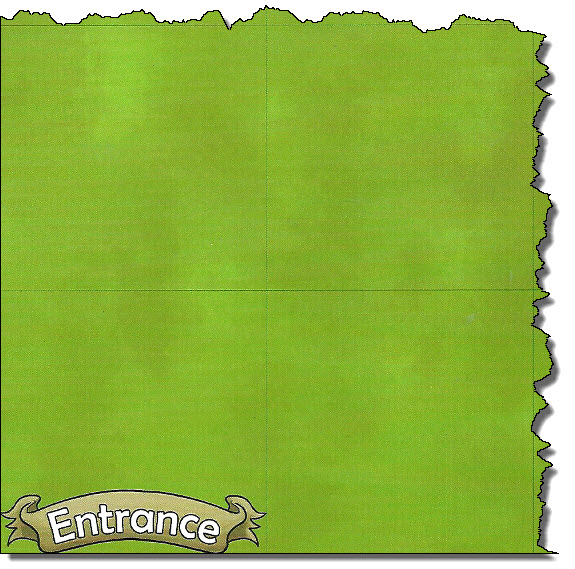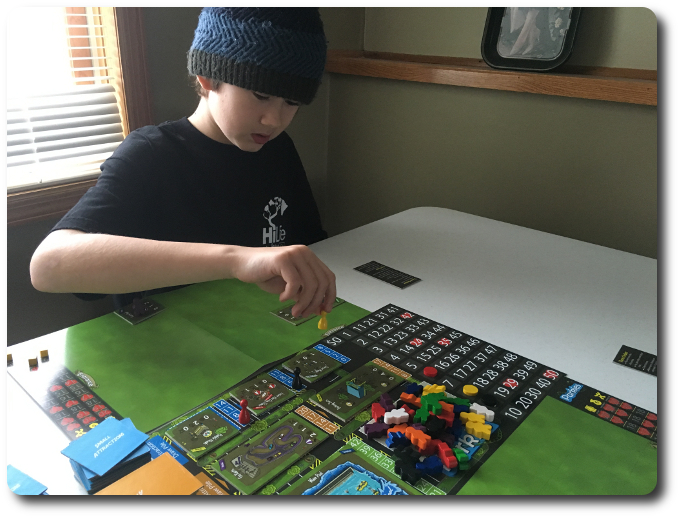
The Basics:
- For ages 8 and up (publishers suggests 12+)
- For 2 to 6 players
- Approximately 60 minutes to complete
Geek Skills:
- Counting & Math
- Logical & Critical Decision Making
- Reading
- Pattern/Color Matching
- Strategy & Tactics
- Visuospatial Skills
- Hand/Resource Management
- Bidding
- Worker Placement
Learning Curve:
- Child – Easy
- Adult – Easy
Theme & Narrative:
- Build an amusement park for fun and profit
Endorsements:
- Gamer Geek approved!
- Parent Geek approved!
- Child Geek approved!
Overview
American technology entrepreneur and academic, Vivek Wadhwa, said “The truth is that entrepreneurship is more like a roller coaster ride than a cruise.” Meaningful words in the context of this game where players will take on the responsibility of creating an amusement park, then attracting parkgoers to make money. Each new ride is a gamble, but there are multiple ways to make a profit in this business.
Parkies, designed by JT Smith and published via the Game Crafter, is comprised of 35 Small Attraction tiles, 22 Medium Attraction tiles, 8 Major Attraction tiles, 6 Bidding pawns, 40 Parkies, 6 Player mats, 1 Bidding mat, 6 Money markers, 18 Track markers, 1 First Player pawn, and 6 Player Reference tiles. The tiles are made of thick cardboard and very durable. The markers and pawns are made out of wood. The mats are made out of thick card stock. The illustrations by Alisha Volkman capture scenes found in the amusement park of your choice, from small vendors of food to large roller coaster attractions that make you vomit said food.
Getting Ready to Open the Park
To set up the game, first place the Bidding mat in the middle of the playing area where all players can easily see and reach it. Collect all the Parkie meeples in a pile next to the Bidding mat. This is the Parkie pool. A space is found on the Bidding mat that is also referred to as the Parkie pool. Feel free to place the Parkies in this location, too, if you think it will help players keep track of how many Parkie meeples are left to use.
Second, organize the Small, Medium, and Major Attraction tiles into their own piles and shuffle face-down. Place 2 stacks of Small Attraction tiles face-down along the side of the Bidding mat. Then place a single face-down stack for the Medium Attraction tiles and 1 for the Major Attraction tiles. The Bidding mat indicates where these piles should be located.

From left to right: Major Attraction, Medium Attraction, and Small Attraction tiles
Third, give each player a Player mat and a Player Reference tile. The Player mat should be placed in front of the player with the lake side facing down. Return any Player mats not used back to the game box.
Fourth, have each player select a color of their choice (blue, red, yellow, black, white, or green) and take the Bidding pawn, Money marker, and Track markers of the same color. Players place the cubes on the “5” value positions found on the Allure, Profitability, and Satisfaction tracks found on their Player mat. Players then place the disc on the “20” value position on the Money track found on the Bidding mat.
Fifth, if there are any Player Reference cards not being used, cover up the noted Attraction spaces found on the Bidding mat. These spaces will not be used during the game. Any Bidding pawns, Money markers, or Track markers not being used should be returned to the game box.
That’s it for game set up. Determine who will be the first player and hand them the First Player pawn. Time to create an amusement park!
Rides, Riches, and Restrictions
Note: The game play summary described here is for 3 to 6 players. See “Game Variants” for a summary of a 2-player game.
Parkies is played in turns with no set number of turns per game, but most games are completed within 10 turns of game play. A single game turn is summarized here.
Step 1: Move and Reveal New Tiles
If there are any Attraction tiles still on the Biddy mat, they are shifted to the right, thus decreasing their overall cost. Attraction tiles only shift once and never “fall off” the Bidding mat. They will remain on the Bidding mat until purchased. Attraction tiles never shift to a space occupied by another Attraction tile or a Player Reference tile.
If there are any open spaces on the Bidding mat for Attraction tiles, a new Attraction tile is taken from the top of the pile, flipped face-up, and placed in the first empty space for that specific attraction type. This is done until all the spaces are filled with Attraction tiles.
Step 2: Bid On Attractions
Staring with the current First Player and continuing clockwise, each player will now place their Bidding marker next to 1 of the currently available Attraction tiles on the Bidding mat. Any Attraction tile can be bid on, but a player cannot bid on an Attraction tile they cannot afford (with the exception of using Parkie Powers, which are described later). Since all players start the game with $20, none of the Major Attraction tiles will be purchased for a few turns, meaning the Small Attraction tiles will be hotly contested over.
Next to each of the Attraction tiles available is a track that lists number values, with the lowest value at the bottom and the highest value at top. The number value indicates how much money the player is willing to spend to bid on the Attraction tile. If a player outbids a previously placed Bidding marker, the player who was outbid takes their Bidding pawn and gets to place it again when it’s their turn. They can, if they so choose, place their Bidding marker to outbid the player who bumped them or place their Bidding marker on any other open bidding space. A player cannot remove their Bidding marker once it’s placed unless they have been outbid.

While each Attraction tile can only have 1 Bidding marker, any number of players can place their Bidding marker in the Parkie Pool space. This will allow the player to collect 1 Parkie meeple of their choice during this turn instead of purchasing an Attraction tile and gain $3.
Once every player has placed their Bidding marker, the turn continues.
Step 3: Pay
All players now pay the bid amount and claim the Attraction tile they won or gain $3 if they used the Parkie Pool. Money is kept track of on the Bidding mat using the Money marker to adjust the player’s current amount.
Step 4: Place Attraction Tile
When an Attraction tile is purchased, it must be placed using a few rules.
All Attractions Must Be Connected Via an Entrance
When a new Attraction tile is placed, it must be connected directly to an “Entrance” space on the Player mat or connected to a series of Attraction tiles that connect back to an “Entrance” space. In other words, a player cannot place an Attraction tile in the middle of their Player mat surrounded by nothing.

Paths Must Connect
The walking paths that surround the attractions depicted on the Attraction tiles have 1 or more path exits. These paths must connect to other Attraction tile paths so that the walking paths never dead-end. A dead-end is considered a path on one Attraction tile that terminates without a connecting path on an adjacent Attraction tile.
Rotation of Tiles is Allowed
Attraction tiles may be rotated to fit and comply with the Attraction tile rules, as long as it stays within the borders of the Player mat.
Adjust Allure, Profitability, and Satisfaction
After placing the new Attraction tile, adjust the Allure, Profitability, and Satisfaction values on the Player mat as noted by the Attraction tile.

Step 5: Move, Pick, and Place Parkies
If the players have any Parkies on their Player mat, they can now move them. A player can move 1 Parkie meeple up to 2 Attraction tiles (following the walking paths) or move 2 Parkie meeples 1 Attraction tile each. There is no limit to the number of Parkies that can occupy the same Attraction tile at one time.
Pick Parkies
For those players who grabbed a Parkie meeple during the bidding, they can now take a Parkie from the Parkie Pool. Any color can be selected. The selection of Parkie meeples always starts with the First Player and continues in turn order sequence. If a player did not bid on a Parkie, they are skipped.
Now all players get to pick a Parkie. Starting with the First Player and continuing in turn order sequence, each player selects a Parkie color that matches the flags found on their Attraction tiles currently located on their Player mat.
Place Parkies
All Parkies collected during this turn must be placed on an Attraction tile connected to an “Entrance” space. If the player does not have any Attraction tiles next to an “Entrance” tile, then the collected Parkies are set next to the Player mat and will come into play during the next turn.
Parkie Powers
Attractions draw crowds and those crowds of Parkies benefit the player. Each Parkie provides the player with a special “Parkie Power” that can be used during the game. Each of these Parkie Powers are summarized here.
- Bid Discount: Each Parkie provides a $2 discount on a bid that matches their color type. The discount stacks, meaning 4 “Green” Parkies would give the player an $8 discount on a green Attraction tile. This discount takes effect only when paying for the Attraction tile, not during the bidding.
- Quick Cash: Any Parkie can be returned to the Parkie Pool to earn $5. If using the money for a bid, the Parkies must be discarded prior to bidding.
- Trump Bids: Normally the highest bid number cannot be overtaken by another bid. By spending 1 Parkie and placing it above the highest bid possible, a player can outbid the current highest bid value. Another player can do the same by spending 1 more Parkie than those already spent to do so. For example, to trump the highest bid would cost 1 Parkie. To trump the first trump would cost 2 Parkies. Any Parkies spent to trump are returned to the Parkie Pool, regardless if the player wins the bid or not.
Step 6: Collect Income & Pass First Player
All players now review their current values in their Allure, Profitability, and Satisfaction tracks. The lowest value of these three categories indicates how much money the player earns for this turn. For example, if Allure was “7”, Profitability was “5”, and Satisfaction is “6”, the player would earn $5. Each player adjusts their own Money track accordingly.
At the very end of the round, the First Player marker is passed to the next player in turn order sequence. A new turn now begins.
Breaking Down the Park
If a player determines that they have built themselves into a corner or no longer want a certain attraction, they can elect to demolish an Attraction tile. This is considered a “free action” and can be done at anytime during the game. The Attraction tile to be demolished is removed from the Player mat and placed on the bottom of the matching pile of Attractions found next to the Bidding mat. Any Parkies on the removed Attraction tile are returned to the Parkie Pool. Each Parkie placed back in the pool earns the player $5.
Closing the Park
The game continues until 1 player has successfully connected all of their “Entrance” spaces via Attraction tiles and paths. A Parkie should be able to enter the park using any “Entrance” space” and exist the park using any “Entrance” space. The current turn is completed as normal and then the game is scored.
If all the Attraction tiles are played, but none of the players have connected their “Entrance” spaces (which is a very rare thing), scoring occurs after the current turn is completed when 2 or more Attraction tiles are exhausted.
When the game ends and before scoring commences, all players may turn in any number of their Parkies for $5 each. However, these Parkies will not be used for other types of scoring.
Players keep track of their scores by taking their Bidding marker and placing it on the “0” position of their Money track. Players should NOT move any other marker at this time. Several different categories are now scored.
Score Money
For every “Heart” symbol the player’s Money marker has met or surpassed, the player earns 1 point. If the players like, they can sell their Parkies at this time, as well, to earn additional points.
Score Attractions
For every unique Attraction tile type in the player’s park, the player earns 1 point. An attraction type can only be scored once. Attraction types are as follows:
- Food
- Ride
- Coaster
- Show
- Water
- Shop
- Park
- Game
Score Matching Parkies
For every Attraction tile that has 1 or more Parkies of the same color, the player earns 1 point. Multiple Parkies on the same Attraction tile do not score more than 1 point, but multiple Attraction tiles can be scored.
Score Special Attractions
For every Attraction tile with a “Heart” symbol, the player earns 1 point.
Score Allure, Portability, and Satisfaction
For every “Heart” symbol the player’s Allure, Profitability, and Satisfaction markers have met or surpassed, the player earns 1 point.
Score Connections
If the player has connected two “Entrance” spaces, they earn 6 points. If the player has connected 3 “Entrance” spaces, they earn 8 points. If the player has connected all 4 “Entrance” spaces, they earn 10 points
The winner of the game is the player with the most points.
Game Variants
There are several game variants available that players can use to change the game. Each are summarized here.
A Park for Two
Game play for 2 players is almost identical to a 3 to 6 player game except for the bidding. New Attraction tiles are not flipped to fill in bidding spaces. Instead, the First Player decides which Attraction tile to flip over. Any Attraction tile can be selected, but only 1 Attraction tile can be flipped. Bidding is done on the flipped over Attraction tile and continues until 1 player passes or both players use the Parkie Pool.
A Park By the Lake
The reverse side of the Player mat has a lake in the middle of it. The “Lake” space cannot be overlapped by any Attraction tile except “Water” Attraction tiles.
To learn more about Parkies, visit the game’s web page.
Final Word
The Child Geeks approached Parkies like an amusement park simulator, which in many respects it is. But not in the way you might think. According to one Child Geek, “I first want to build the amusement park I would want to visit and then I’ll make sure the meeples visit it, too.” Another Child Geek said, “This game is like a puzzle, where you have to get the right rides and put them in the right place. The meeples are part of the puzzle, too, so you have to keep them in mind when you are opening your park.” I was very impressed with the Child Geek’s ability to quickly learn and play the game. The only problem the Child Geeks had was bidding too high too soon, reducing their overall buying power, and forcing them to sell meeples. They learned their lesson and became much more reserved, but not always. As one Child Geek put it, “Sometimes you have to splurge to get the perfect tile.” All the Child Geeks voted to approve Parkies.

My oldest son hesitates as he contemplates his options before placing his bid…
The Parent Geeks were intrigued by the game from the start. According to one Parent Geek, “I like how your amusement park begins to appear in front of you. It’s very satisfying to buy just the right tile that connects and grows your attractions.” Another Parent Geek said, “This is a challenging game, but it’s also a lot of fun. I feel like I need more work on judging the value of a tile, but I never feel cheated when I purchase one.” Which is to say, the values of tiles depreciate, but only to a point. If a player can afford to wait or has no choice, the tile in question could be purchased for less than its initial asking price. However, anyone with the cash can buy the tile first. Pay a lot now or a little later, but run the risk of not getting the tile at all. The true value of a tile is based on demand. The Parent Geeks enjoyed every aspect of the game and fully approved Parkies.
The Gamer Geeks very much enjoyed themselves. According to one Gamer Geek, “I love games that give players multiple ways to win, are always different when you play them, and challenge a player to carefully consider their timing. This is a great game.” Another Gamer Geek said, “I’ve played games like this before, but Parkies doesn’t feel like a copy cat. It has it’s own theme, it’s own play style, and own challenges.” And finally one last Gamer Geek wanted to be quoted, “It’s light, it’s tight, and it’s alright!” So, there you go. All the Gamer Geeks voted to approve Parkies without hesitation, finding it to be a game they’d play at their elitists tables again and again.
Parkies has been compared to Vegas Showdown. The comparison is accurate on several fronts. First, the players bid on tiles to use to build. Second, the players must build using restrictive rules that still allow for a great deal of creativity. Third, a player must connect and join their tiles with certain edges to complete the goal. Even the victory is somewhat alike in that players count points using a list of criteria.
But this is no Vegas Showdown. Other than the different theme, the game play is similar, but the use of Parkie meeples adds a new dimension that opens up the door to different and unique opportunities. I would describe Parkies as “similar but not identical”. Of course, if you’ve never played Vegas Showdown, then ignore everything I just said.
I find that Parkies greatest strength is the multiple ways in which a player can attempt to score points and sacrifice those same means and ways to obtain other necessary resources. The Parkie meeples are the best example of this, allowing the player to use them for special abilities or maneuver them as quickly as possible to earn points at the end of the game. Brilliantly, there are only so many Parkie meeples to go around, meaning players must balance their building of their amusement park with attracting a crowd. A player must continually determine what action will benefit them not only the most this turn, but also in the turns to come.
Parkies begins to wobble in the knees when you throw 5 or 6 players on top of it. Tile and meeples are in short supply, reducing the the amount of freedom and opportunity for players. However, I do not personally count this as a weakness in the game or game play. Rather, it’s a sure indicator that players best focus in and work hard to get what they want as quickly as they want it. I rather enjoyed that aspect, as it meant that the game with fewer players had a more casual feel to it and more players made it borderline cutthroat. This aspect of the game bothered some, but barely registered with the majority.
One aspect of the game that everyone mentioned were the mats. Everyone wanted the Player and Bidding mats to be as thick as the tiles. The mats did not impede the game play to any degree, but the differences in thickness was note again and again. Interestingly enough, two of the players suggested the mats be cut in half and laminated. I won’t be doing such a thing, but it’s a viable solution to what many of our players saw as an irksome problem. On a bit of a side note, the same comments were given when players enjoyed a game of Vegas Showdown, where the “mats” are actually fold-out paper.
I’m very pleased with Parkies. It has just enough depth to keep me coming back, requires strategy to play, you must be tactical in your decision making, and players are given a lot of room to find their own path to victory. There’s a lot of replayability in this game and different things to try, but the game isn’t difficult to learn and plays very smoothly. It’s the kind of game I can play once in a while or every other night, enjoying each session. All in all, an excellent game that made everyone happy. If you enjoy games where you have to consider multiple angles, challenge yourself to reconsider every option, and enjoy exploring different strategies and tactics, do sit down and play Parkies. This is one ride you’ll be happy you jumped on.
This game was given to Father Geek as a review copy. Father Geek was not paid, bribed, wined, dined, or threatened in vain hopes of influencing this review. Such is the statuesque and legendary integrity of Father Geek.
Discover more from Father Geek
Subscribe to get the latest posts sent to your email.





